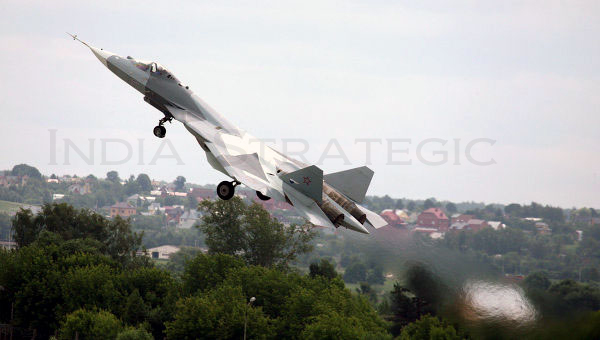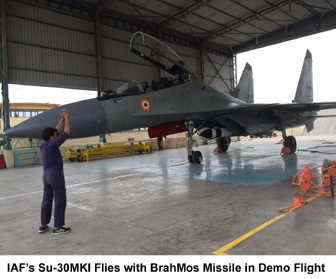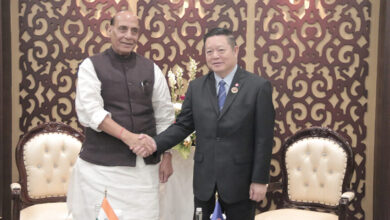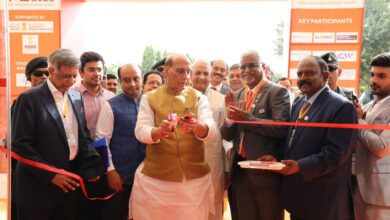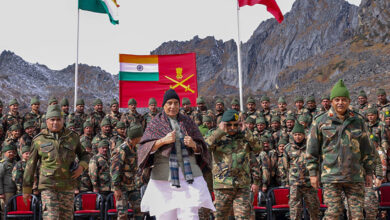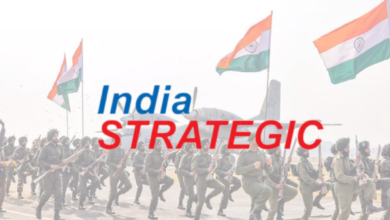Chief of the Air Staff Air Chief Marshal NAK
Browne told India Strategic in an
interview on IAF’s 80th Anniversary that
all these aircraft would be single seaters, the
same which the Russian Air Force will have but
some components like onboard computers and systems
would be different as in the case of SU 30 MKIs.Now designated PMF, or Perspective Multirole
Fighter by Russia, the Indian aircraft would be
made in India with Russian assistance, he said
adding that discussions with the Russian Government
are already on.India’s HAL, which will manufacture the Indian
version of the aircraft, has already committed
US $6 billion for initial expenses in joint development
with Russia’s United Aircraft Corporation
(UAC), which will provide the super cruise engines
and certain stealth technologies.
India and Russia had signed an agreement in
this regard 21 Dec 2011, to set up a 50:50 joint
venture on the lines of BrahMos Aerospace and
share development work. HAL will be aided by DRDO.
Indian scientists are keen to pool in Research
and Development (R&D) effort, and the agreement
calls for joint development, particularly in design,
guidance systems and onboard software. That means
India will also have a proprietary share on Intellectual
Property Rights (IPR).
The exact costing is yet to be worked out but
inclusive of the development costs, the figure
could be around USD 30 billion, according to HAL
sources.
Notably, a figure of 200-plus of two-seater
version for India was considered earlier with
possible induction from 2017 with an initial lot
from Russia. Development in that time frame however
is not happening.
To cut down on the development costs and the
timelines, IAF has plans to begin their induction
from 2020 onwards, Air Chief Marshal Browne said.
Discussions with Russia are on to sign the first
R&D phase, and the first prototype is likely
to be delivered to India in 2014 followed by two
more in 2017 and 2019. The series production then
“will only be ordered based on the final
configuration and performance of the third prototype.”
The Air Chief observed that Speed, Reach, and
Precision are the keywords for IAF’s Transformation
that is going on now.
He observed that various acquisition programmes
of the Indian Air Force were going on as normal
and so were the upgrade programmes. IAF had already
spent around Rs 150,000 crores (approx $ 30 billion)
in the last five years and that there was adequate
budgetry support to execute its transformation
programmes by 2027, when all the 42 combat squadrons
sanctioned by the Government will be operational.
He reiterated that he expected the deal for
126 French Rafale Medium Multirole Combat Aircraft
(MRCAs) to be finalised by March 2013. There are
virtually daily meetings between the aircraft
partners, Dassault, Thales and engine maker Snecma
on the one side and IAF, HAL and Ministry of Defence
representatives on the other.
On the legacy aircraft, he said that while the
Soviet vintage IL 76 and AN 32 transport aircraft
were already under upgrades to give them an extended
life of 10 to 15 years, the tender to upgrade
IAF’s 100 odd Jaguar aircraft with new engines
was about to be issued – likely by October
end – to the US Honeywell.
IAF tenders for Combat, Heavy Lift helicopters
and Midair Refuelers have already been opened
over three weeks beginning mid-September. While
the combat helicopter deal has gone to Boeing
Apache AH-64D, because Russia withdrew its Mi
28 helicopter, the winner in the other two would
be decided on the basis of lifecycle costs. Calculations
were being done now, and it should take a couple
of months in each case to declare the winner.
Ministry sources told India Strategic
that the selection process sometimes got delayed
as vendors either give incomplete answers or left
some columns blank. As disputes over interpretation
can arise, it is better to get clarifications
right in the beginning.
Notably, all the aircraft deals with Soviet Union/
Russia so far have been on government to government
basis, including for the FGFA. This is the first
time that Russian aircraft – Mi 26 heavy
lift vs. Boeing CH 47F Chinook, and Il 78 against
Airbus MRTT – are pitted in global competitions
in India, involving mandatory offsets. If the
Russians win, they will have to do what is required
by the DPP (Defence Procurement Policy) and invest
30 percent of the deal back in Indian defence
industry.
The FGFA programme began in 2006 and MTA in
2007, and both these, as well as for the Indian
Navy’s 45 Mig 29 shipboard fighters, are exempt
from offsets. The Mig 29 programme is part of
the Gorshkov aircraft carrier’s acquisition programme,
signed well before the DPP came in place. |


